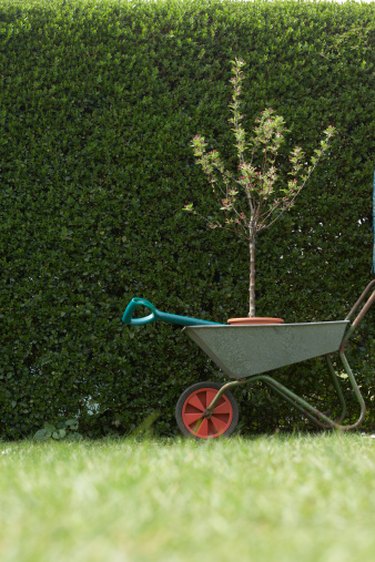
The terms "hardwoods" and "semi-hardwoods" may often be confused with grades of construction lumber, or even types of wood found on different trees. While there are trees that produce hardwoods and softwoods, there are no trees designated as semi-hardwoods. Comparisons between hardwoods and semi-hardwoods typically refer to stages of tree growth and the two types of plant cuttings gardeners use to propagate new trees and shrubs.
Definition
Video of the Day
Wood is referred to as semi-hardwood when it is not soft and new, but is not yet mature enough to be hard.The term semi-hardwood refers to branches in tree growth that are beginning to mature. Hardwood refers to new branch growth that has matured over the life of a growing season. Semi-hardwood branches bend and snap, but are not as hard and brittle as branches considered to be hardwood.
Video of the Day
Cutting and Growing
Semi-hardwood branches should be cut in six- to eight-inch lengths from the upper portion of a tree's crown. A semi-hardwood cutting grows tree roots in approximately four to six weeks. Hardwood cuttings should only be taken from plants or trees that lose their leaves, unlike evergreens which can have a semi-hardwood cutting. A hardwood cutting has less chance of success than a semi-hardwood cutting, and takes six months or longer to produce roots.
Seasons
Semi-hardwood cutting should be done in late summer. Hardwood cuttings should not be done until the tree goes dormant in late fall or early winter. While semi-hardwood branches can grow roots on their own, hardwood cutting may need to be placed in a greenhouse with a misting system to keep them moist.
Plant Types
Semi-hardwood cuttings are often used for evergreens and perennials. Hardwood cuttings are typically used to propagate deciduous and soft-wooded trees, such as weeping willows, poplars, junipers and English holly. Some plants, such as Japanese holly, can be grown from either a semi-hardwood or hardwood cutting, but the cuttings must be done during late summer for semi-hardwoods, and in the late fall or winter for hardwoods.
- University of Nebraska-Lincoln: UNL Extension;Backyard Farmer; Propagation with Softwood, Semi-Hardwood and Hardwood Cuttings
- Freeplants: Propagating Hardwood Cuttings of Deciduous Plants
- Plant Propagation: Plant Propagation Techniques;Cutting
- Plant Propagation:Plant Propagation Technique Plant by Plant
- NC State University: Plant Propagation by Stem Cuttings: Instructions for the Home Gardener